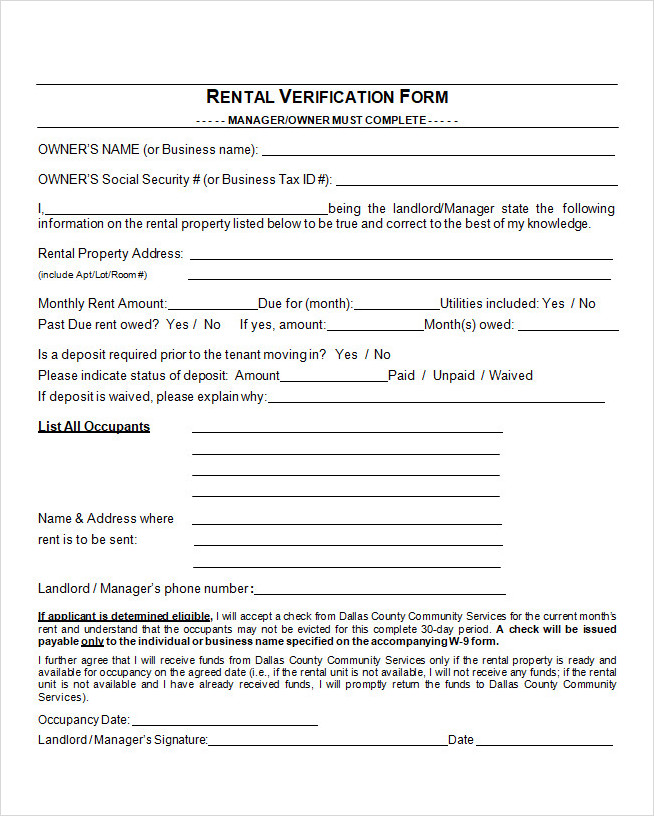When it comes to renting a property, both landlords and tenants have certain responsibilities and expectations. One of the key aspects of this process is the rental verification form. This document is crucial in ensuring that both parties are protected and that the rental agreement is fair and transparent.
In this article, we will explore what rental verification forms are, why they are important, and how to use them effectively.

What is a Rental Verification Form?
A rental verification form is a document that is used to gather information about a potential tenant’s rental history. It is typically filled out by the tenant’s previous landlord or property manager and provides essential details about the tenant’s rental experience. This form helps landlords assess the tenant’s reliability, payment history, and overall suitability.
Some of the information typically included in this verification form includes:
- Tenant’s name and contact information
- Previous rental property address
- Length of tenancy
- Monthly rent amount
- Payment history
- Condition of the rental property upon move-out



Why are Rental Verification Forms Important?
Rental verification forms are crucial for both landlords and tenants. They provide valuable information that helps landlords make informed decisions about potential tenants. By verifying a tenant’s rental history, landlords can assess their ability to pay rent on time, their reliability, and their general conduct as a tenant. This information is vital for landlords to ensure that they are renting their property to responsible individuals who will take care of the property and fulfill their obligations.
For tenants, these forms can help build trust with landlords. By providing accurate and honest information about their rental history, tenants can demonstrate that they are responsible and trustworthy individuals. This can increase their chances of being approved for a rental property and can also help them negotiate better lease terms.



When should Rental Verification Forms be Used?
Rental verification forms should be used during the tenant screening process. This process typically takes place after a potential tenant has filled out a rental application and before the lease agreement is signed. Landlords need to gather accurate information about a tenant’s rental history before entering into a legally binding agreement.
It is recommended that landlords request verification forms from the tenant’s previous landlord or property manager for at least the past two years. This allows landlords to get a comprehensive understanding of the tenant’s rental history and make an informed decision about their suitability as a tenant.


How to Use Rental Verification Forms Effectively
To use rental verification forms effectively, landlords should follow these steps:
- Request the form from the tenant’s previous landlord or property manager: Contact the previous landlord or property manager and ask them to fill out the rental verification form. Provide them with any necessary instructions or guidelines.
- Check the information provided: Review the completed verification form and cross-reference it with the information provided by the tenant on their rental application. Look for any discrepancies or red flags that may indicate potential issues with the tenant.
- Contact the previous landlord: If there are any concerns or questions about the information provided in the verification form, reach out to the previous landlord or property manager for clarification. This can help ensure that the information is accurate and reliable.
- Make an informed decision: Based on the information gathered from the verification form and other aspects of the tenant screening process, make an informed decision about whether to approve the tenant’s application or not. Consider factors such as payment history, rental references, and employment stability.


Benefits of Using Rental Verification Forms
Using rental verification forms offers several benefits for both landlords and tenants. Some of the top benefits include:
- Reduced risk of renting to unreliable tenants: These forms allow landlords to gather information about a tenant’s rental history, payment history, and conduct as a tenant. This helps reduce the risk of renting to individuals who may not fulfill their obligations or cause damage to the property.
- Increased trust between landlords and tenants: By providing accurate and honest information through the forms, tenants can build trust with landlords. This can lead to better lease terms, increased chances of approval, and a more positive renting experience.
- Improved decision-making: These forms provide landlords with valuable information that can help them make informed decisions about potential tenants. By considering factors such as payment history and rental references, landlords can choose tenants who are more likely to fulfill their obligations and take care of the property.
- Protection for both parties: These forms help protect both landlords and tenants by ensuring that the rental agreement is fair, transparent, and based on accurate information. This can help prevent future misunderstandings, disputes, and legal issues.


Conclusion
Rental verification forms are an essential tool for both landlords and tenants. They provide valuable information that helps landlords make informed decisions about potential tenants, while also allowing tenants to demonstrate their reliability and trustworthiness. By using rental verification forms effectively, landlords can reduce the risk of renting to unreliable tenants and build a positive rental experience for both parties involved.